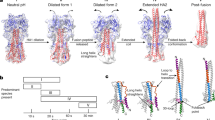Abstract
THE mechanism of virus induced cell fusion is not clear. Among others, Sendai virus1,2 and Newcastle disease virus3 have been used to induce cell fusion; both viruses belong to the myxovirus group. In the early stages of fusion the virus is absorbed onto the cell surface and cytoplasmic bridges are formed between adjacent cells4. Okada5 has measured the haemolytic, haemagglutination and sialidase activities of Sendai virus, but found that the ability of the virus to fuse cells together could not be correlated with these activities. Kohn6,7 has investigated the effect of modified Newcastle disease virus on animal cells and found that fusion was prevented only when the lipid membrane of the virus was hydrolysed. Kohn6 also found that treatment of the cells with neuraminidase before the addition of virus also prevented fusion. The presence of sialic acid residues in the cell wall has been described by Kraemer8 and these residues could be the site of action of neuraminidase. The myxoviruses have a lipoprotein surface with mucopolysaccharide “haemagglutination spikes”9 and it is thought that the neuraminidase is situated between these spikes, as appears to be the case for influenza virus10.
This is a preview of subscription content, access via your institution
Access options
Subscribe to this journal
Receive 51 print issues and online access
$199.00 per year
only $3.90 per issue
Buy this article
- Purchase on Springer Link
- Instant access to full article PDF
Prices may be subject to local taxes which are calculated during checkout
Similar content being viewed by others
References
Okada, Y., Biken's J., 1, 103 (1958).
Harris, H., Watkins, J. F., Ford, C. E., and Schoefl, G. I., J. Cell Sci., 1, 1 (1966).
Johnson, C. F., and Scott, A. D., Proc. Soc. Exp. Biol. and Med., 115, 281 (1964).
Schneeberger, E. E., and Harris, H., J. Cell Sci., 1, 401 (1966).
Okada, Y., Exp. Cell Res., 26, 108 (1962).
Kohn, A., Virology, 26, 228 (1965).
Kohn, A., Virology, 31, 385 (1967).
Kraemer, P. J., J. Cell Biol., 33, 197 (1967).
Horne, R. W., Waterson, A. P., Wildy, P., and Farnham, A. E., Virology, 11, 79 (1960).
Noll, H., Aoyagi, T., and Orlando, J., Virology, 18, 154 (1962).
Butterworth, P. J., and Moss, D. W., Nature, 209, 805 (1966).
Morton, R. K., Biochem. J., 57, 595 (1954).
Davis, B. J., Ann. NY Acad. Sci., 121, 404 (1964).
Meiselman, N., Kohn, A., and Danon, D., J. Cell Sci., 2, 71 (1967).
Lansing, A. I., Belkhode, M. L., Lynch, W. E., and Lieberman, I., J. Biol. Chem., 242, 1772 (1967).
Author information
Authors and Affiliations
Rights and permissions
About this article
Cite this article
SPENCER, T. Action of Sendai Virus and Neuraminidase on the Alkaline Phosphatase Isoenzymes of HeLa Cells. Nature 215, 985–986 (1967). https://doi.org/10.1038/215985a0
Received:
Issue Date:
DOI: https://doi.org/10.1038/215985a0
Comments
By submitting a comment you agree to abide by our Terms and Community Guidelines. If you find something abusive or that does not comply with our terms or guidelines please flag it as inappropriate.



